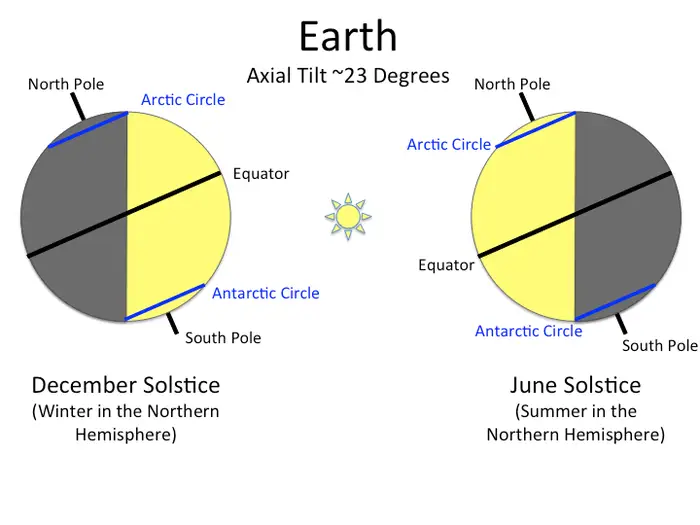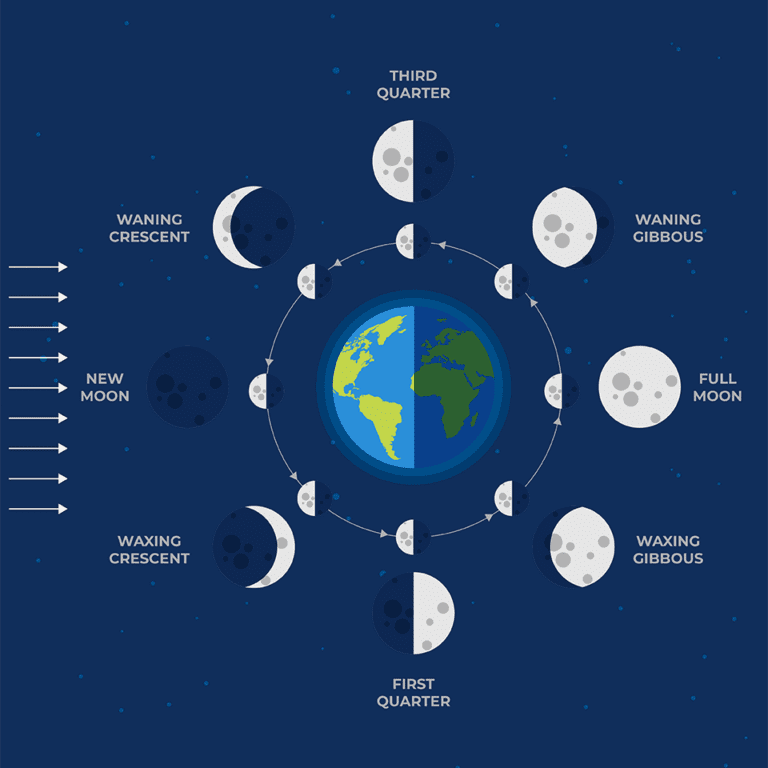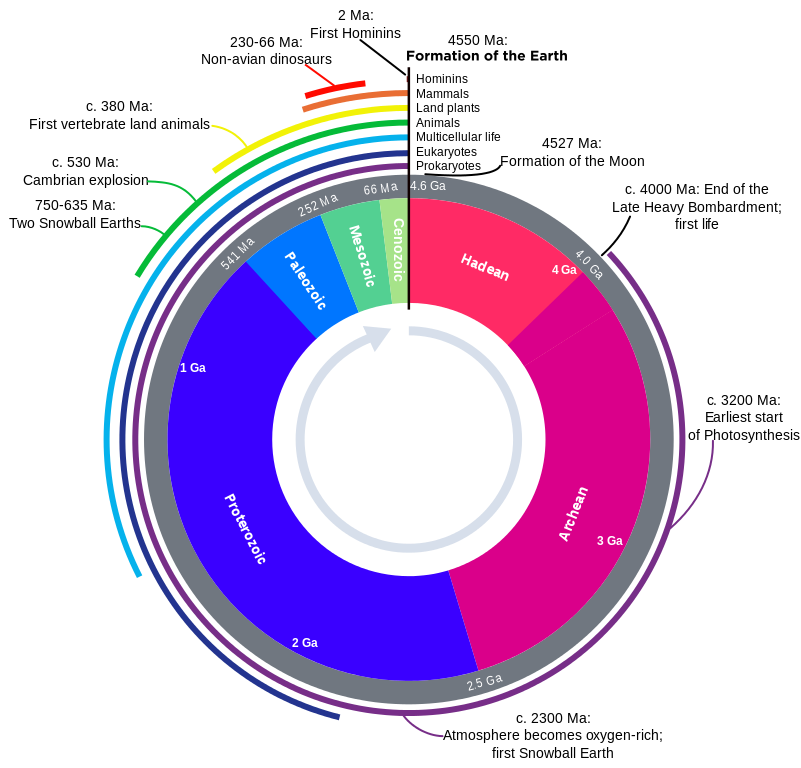If you believe God wrote the bible, or whatever religious document guides you, and take it literally, then just move on. Nothing to see here…
Humans need to get some perspective – this planet has been here for a time longer than you can fathom. The notion that we see historic trends is almost laughable. Certainly arrogant.
I like to think about time. Ironic; ‘wasting’ it through contemplation instead of productively using what little we have. Because we are such short lived creatures (we are no Bristlecone Pine…), we think 100 years is a long amount of time (at least when young). We say bacteria have a short lifespan, maybe a day (actually, hard to say), but ours is really not much ‘better’ – when you think about all Time (big T).
Here is a very short summary of timekeeping, a digression from the real topic (just because it is interesting): Early on we needed to know when seasonal migrations happened, fish, birds, deer; so we could be ready to kill and eat them. Later, we needed to know when to plant crops. We developed time trackers like Stonehenge. We used the stars as they seemed to float steadily across the night sky.
Quick refresher: Day and night are due to this planet spinning like a top, the part facing the Sun gets daylight. Months were defined, initially, by our moon spinning around the Earth. The different phases, again, due to sunlight hitting the part not being shadowed by the earth. Years are marked by Earth’s orbit around our sun. Seasons are made in the northern and southern latitudes because our planet’s spin axis is canted about 23 degrees, and always in the same direction, so the different hemispheres get more/less exposure to the Sun; Summer/Winter.


That was what initially determined the marking of time. Hours? Egyptians divided the day into 12 segments, which varied by the season. For astronomers and nautical navigation Hipparchus divided the globe (yes, people knew it was round even then – that Columbus thing is a myth!) into 360 even segments which Ptolemy then subdivided into partes minutae primae, the “first minutes” (minutes), and a further subdivision partes minutae secundae, the “second minutes” (second). Since these were longitude lines (running pole to pole) they represented time as the Earth spun. Each degree represents 4 actual time minutes. Fifteen equal an hour (and different distances, depending on latitude, about 69 miles at the Equator). Before Hipparchus, lines ran through important cities, regardless of their position on the globe. Lot’s of inaccuracy. Additionally, orbits are not perfectly round, our tilt is slowly decreasing. Our orbit is not exactly 365 days each year. Time varied. Locally this was no big deal. Each town would set their clocks to noon when the sun was at its height. For empires, spanning continents, this did not work well.
How do you track time between distant locations if noon is different everywhere? Where does the time start? Nations set up their own reference points; Paris, Greenwhich, Washington. In 1884 the World agreed to use Greenwhich as the 0 in longitude (the Prime Meridian), where time starts each day (the base time zone of the 24 spanning the globe – each 15 degrees). Most recently, in our quest to track time more and more accurately and uniformly, we moved from an astronomical reference (Sun and Moon) to a chemical one; the transition between states of a laser excited Cesium isotope (the second is now defined as the duration of 9,192,631,770 energy transitions. ‘New’ minutes, hours, days etc are built from that). Supposedly, the current US ‘atomic clock’ is only off 1 second every 300 million years. Considering how early clocks did not even have faces (just bells), and only added minute and second hands later when that degree of accuracy became possible, we are getting better.
So timekeeping is pretty cool, the history and evolution, the way it changed and how we kept track of it; sticks in the sand to atomic fluctuations. But that is not what I want to talk about here. I want to impress upon you the SPAN of time, relative to our lives.
I once taught field based science to kids. To illustrate distances in Space we would have one kid be the Sun and stick her at the edge of a big field. Then we would walk and walk and periodically put someone else as the next planet. If the Earth person was 10 feet from the Sun girl, then Pluto (I know, no longer a planet, but still part of our Solar System) was 500 feet away. Our time is like that. Vast. Hard to envision.
We experience just a blip. I wait for some sci-fi master to write a story where the aliens among us don’t even notice us because their second equivalent is like our 1000 years. They don’t even see our life as a blur on this planet. We see them as unmoving rocks.
So, first, let’s get this out of the way: I don’t know enough to believe that the background radiation ‘noise’ found on radio telescopes is really indicative of some Big Bang event that can be dated. And some doppler shifts in it tell you how fast its expanding and so how long ago it happened, yada yada… 13.8 billion years ago (13,800,000,000) … Nah… too hard and the foundations it rests on too nebulous for me.
But less old stuff I can buy into. Show me some layered beds of fossils or some radiactive decay in some rocks on this planet and I can believe. I still cannot really comprehend the time scale, but I can accept the values as legitimate. Certain physical rules apply on this planet. Admittedly, for our brief time studying radioactivity it has remained constant, but maybe that changes in some weird circumstances that occurred before humans were around. So, sure, it is possible that dating based on radioactive decay is off. But we have no indication of that.
The time scale is still hard though. I actually have a trilobite fossil I found in Pennsylvania from Cambrian times. Life from 500 million years ago. I can’t really grasp the difference between half a billion (500,000,000) and the 13.8 billion. Can you? A friend got married in a church from the 1200s. Everyone thought that was so long ago. I have been to King Solomon’s temple mount in Israel, built over 3000 years ago. That seems like ancient times. But, really, it was just yesterday. That scale is on the edge of comprehension for me. Seeing it did not help. Pretty cool though…
Humans are pretty new. Life on this planet, as far as we know so far (fossil bacteria from Canada), started around 3.7 billion years ago. Maybe longer; fossils only tell you what was found, not what lies undiscovered that might push the boundaries farther. The oldest vertebrate (fish) fossil dates about 480 million years ago. Dinosaurs lasted about 175 million years, till about 66 million years ago. Human-like critters left some bones (Sahelanthropus and Orrorin tugenensis) from about 7 million years ago (give or take a million years!). Human-like because they seem to have bone structure suggesting they walked upright on two legs. Nothing more besides being of a primate lineage. Australopithicenes, who used tools (which chimps and Bonobos, and several other animals do today as well) were found as far back as 4+ million years ago. Their skulls had brains of about 450 cm3, about the same size as modern Chimpanzees. Homo habilis was 2.5 million years ago with a 600 cm3 brain case and better tools. About 1.8 million years ago, we find Homo erectus, brain size started to increase to 1000 cm3. There is evidence of the controlled use of fire about 800,000 years ago with this fellow. Neanderthals (brain size 1410 cm3), agriculture, domestication of other animals, sophisticated hunting, are found from 280,000 years ago to about 28 thousand years ago. Their brain sizes averaged about 1410 cm3. Cro-magnon (modern Homo sapiens) are found as far back as 45,000 years ago. Contemporaneous with Neanderthals, who appeared to have been less violent, and were probably exterminated by our kind (the Homo sapiens). Because that is what we do. Early Homo sapiens had brain sizes of about 1600 cm3. Our contemporary brains average about 1350 cm3. Yup, they have gotten smaller. I threw in brain sizes for fun. Up until we learned modern brains have become smaller, this was used to show our ongoing evolutionary advancement. And chimps? They, ounce for ounce and structure-wise, have pretty much the same brains as hours… Um…, yeah.
And just as another fun aside: We have been stagnating morphologically recently (besides the shrinking brain size and obesity), perhaps because the big changes in Hominids usually came as a result of large environmental changes (ie climate fluctuations) and we have lived through relatively stable times. This planet selects new forms to suit the environment. So maybe we are in for some exciting new humanoids soon!
So look at a nice purloined graphic of this planet’s time (Woudloper from Hardwigg, Wikimedia Commons) :
Ga = 1 billion years ago
Ma = 1 million years ago
Periods (e.g. Precambrian) have Eons (e.g. Hadean, Archean, etc) which have Eras which have periods which have Epochs which have Ages. Spans are random. I think … it is all unnecessarily confusing.
Really, we have gone from using crudely shaped rocks to supercomputers and creating artificial intelligence in 2.5 million years. Actually, much less. It sounds like a long time, but it isn’t. It is far less, not even a breath when you only consider ‘modern times’ – the start of our current date system. See that barely discernible little brown blip to the left of noon? That is 2 million years of humanities existence relative to the rest of this planet’s time. A blip. A gnat. Nothing. We would not even consider Homo habilis human if we saw them today. That was the 2 million years ago. Hell, we kill and EAT chimpanzees and other primates in Africa now – and their brain sizes are the same as habilis. We really don’t think, proudly, ‘human’ till we get to ‘civilization’ (though there is evidence of trade between groups as far back as 140,000 years, clothing and ritual burial 50,000 years ago, with art, villages, structures, about 52,000 years ago in Australia). You cannot even see that amount of time on the graph. Too small. And oldest writing? 5000 years back. First real computer, 1946. Internet, 1958 (ARPA/DARPAnet). Moon landing, 1959. iPhone, 2007.
Where do you want to draw the line? 140,000 or 7 million years – out of 3.7 billion. Our time here has truly been insignificant until you consider our outsized impact on this planet. Does that make us great? Significant? Hell, algae had a huge impact (oxygen).
So when someone tells me that crime is getting worse, the stock market will keep going up, the earth is getting unsustainably warmer, etc. I think “does 5, 10, or 100 years constitute a trend?”… Can it last? Is it significant? If I were a dinosaur and knew my progeny were going to be sticking around for another 100 million years… maybe. But as a human… ?